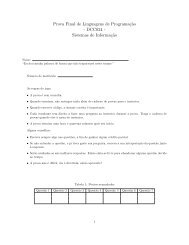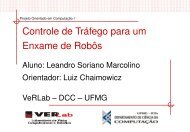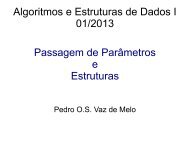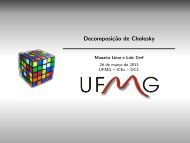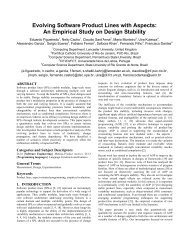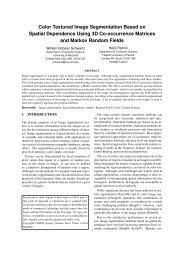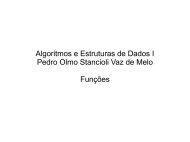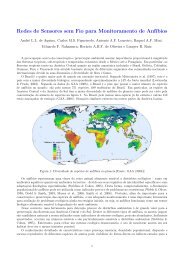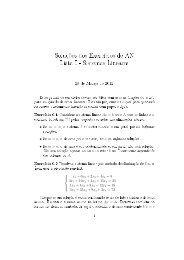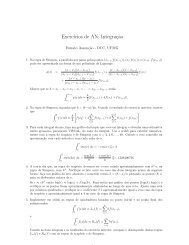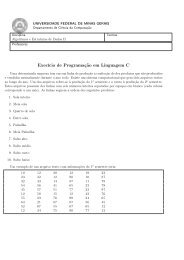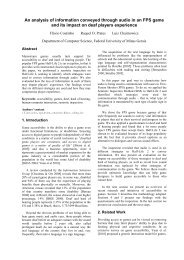Técnicas de Otimização de Código para Placas de ... - UFMG
Técnicas de Otimização de Código para Placas de ... - UFMG
Técnicas de Otimização de Código para Placas de ... - UFMG
Create successful ePaper yourself
Turn your PDF publications into a flip-book with our unique Google optimized e-Paper software.
__global__ void matMulUnroll ( f l o a t∗ B, f l o a t∗ C, f l o a t∗ Pd , i n t Width ) {<br />
__shared__ f l o a t Bs [ TILE_WIDTH ] [ TILE_WIDTH ] ;<br />
__shared__ f l o a t Cs [ TILE_WIDTH ] [ TILE_WIDTH ] ;<br />
i n t t x = threadIdx . x ;<br />
i n t t y = threadIdx . y ;<br />
i n t Row = b l o c k I dx . x ∗ TILE_WIDTH + t x ;<br />
i n t Col = b l o c k I d x . y ∗ TILE_WIDTH + t y ;<br />
f l o a t Pvalue = 0;<br />
for ( i n t m = 0; m < Width / TILE_WIDTH ; ++m) {<br />
Bs [ t y ] [ t x ] = B [ Col ∗ Width + (m ∗ TILE_WIDTH + t x ) ] ;<br />
Cs [ t y ] [ t x ] = C[Row + (m ∗ TILE_WIDTH + t y ) ∗ Width ] ;<br />
__syncthreads ( ) ;<br />
Pvalue += Bs [ t y ] [ 0] ∗ Cs [ 0 ] [ t x ] ;<br />
Pvalue += Bs [ t y ] [ 1] ∗ Cs [ 1 ] [ t x ] ;<br />
Pvalue += Bs [ t y ] [ 2] ∗ Cs [ 2 ] [ t x ] ;<br />
Pvalue += Bs [ t y ] [ 3] ∗ Cs [ 3 ] [ t x ] ;<br />
Pvalue += Bs [ t y ] [ 4] ∗ Cs [ 4 ] [ t x ] ;<br />
Pvalue += Bs [ t y ] [ 5] ∗ Cs [ 5 ] [ t x ] ;<br />
Pvalue += Bs [ t y ] [ 6] ∗ Cs [ 6 ] [ t x ] ;<br />
Pvalue += Bs [ t y ] [ 7] ∗ Cs [ 7 ] [ t x ] ;<br />
Pvalue += Bs [ t y ] [ 8] ∗ Cs [ 8 ] [ t x ] ;<br />
Pvalue += Bs [ t y ] [ 9] ∗ Cs [ 9 ] [ t x ] ;<br />
Pvalue += Bs [ t y ] [ 1 0 ] ∗ Cs [ 1 0 ] [ t x ] ;<br />
Pvalue += Bs [ t y ] [ 1 1 ] ∗ Cs [ 1 1 ] [ t x ] ;<br />
Pvalue += Bs [ t y ] [ 1 2 ] ∗ Cs [ 1 2 ] [ t x ] ;<br />
Pvalue += Bs [ t y ] [ 1 3 ] ∗ Cs [ 1 3 ] [ t x ] ;<br />
Pvalue += Bs [ t y ] [ 1 4 ] ∗ Cs [ 1 4 ] [ t x ] ;<br />
Pvalue += Bs [ t y ] [ 1 5 ] ∗ Cs [ 1 5 ] [ t x ] ;<br />
__syncthreads ( ) ;<br />
}<br />
Pd [ Col ∗ Width + Row] = Pvalue ;<br />
}<br />
Figura 1.26. Multiplicação <strong>de</strong> matrizes após<br />
a aplicação do <strong>de</strong>senrolamento.<br />
seja N 2 /2 o tamanho <strong>de</strong> cada ladrilho. Temos então, um total<br />
<strong>de</strong> 2(N/(N/2)) 2 ladrilhos. Cada ladrilho é lido N/(N/2) vezes.<br />
Portanto, temos 4N 2 leituras da memória global. Dadas as 2N 3<br />
leituras do programa original, observamos uma redução substancial<br />
<strong>de</strong>stes acesso, com consequâncias não menos notáveis<br />
<strong>para</strong> o <strong>de</strong>sempenho da aplicação ladrilhada: o programa da figura<br />
1.24 é cerca <strong>de</strong> 25% mais rápido que o programa da figura<br />
1.22, quando executado em uma placa GPU 9400M.<br />
Desenlaço. Aumentamos a taxa <strong>de</strong> trabalho útil realizado por<br />
um kernel diminuindo a quantida<strong>de</strong> <strong>de</strong> instruções que não realizam<br />
operações <strong>de</strong> ponto-flutuante – no caso <strong>de</strong> um programa<br />
que produz saída neste formato. Entre estas instruções, <strong>de</strong>stacam-se<br />
as operações <strong>de</strong> acesso à memória e as operações que<br />
controlam o fluxo do programa: <strong>de</strong>svios condicionais e incon-<br />
30



